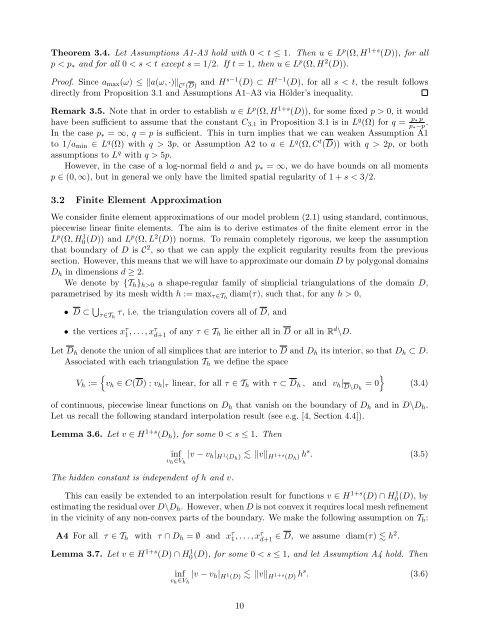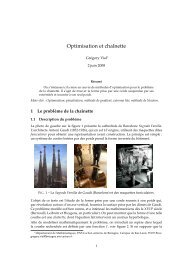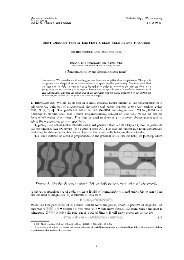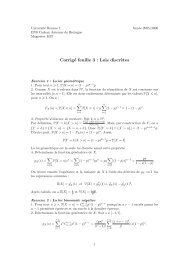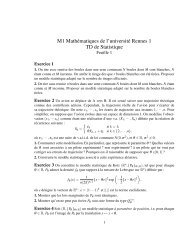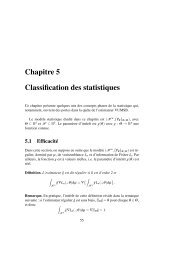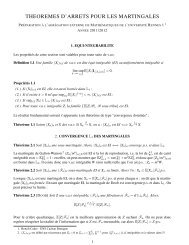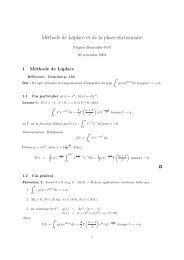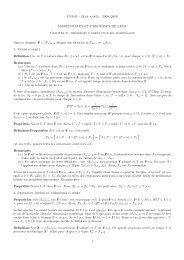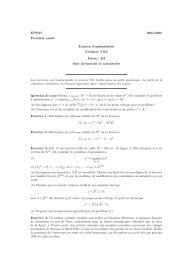Bath Institute For Complex Systems - ENS de Cachan - Antenne de ...
Bath Institute For Complex Systems - ENS de Cachan - Antenne de ...
Bath Institute For Complex Systems - ENS de Cachan - Antenne de ...
You also want an ePaper? Increase the reach of your titles
YUMPU automatically turns print PDFs into web optimized ePapers that Google loves.
Theorem 3.4. Let Assumptions A1-A3 hold with 0 < t ≤ 1. Then u ∈ L p (Ω, H 1+s (D)), for allp < p ∗ and for all 0 < s < t except s = 1/2. If t = 1, then u ∈ L p (Ω, H 2 (D)).Proof. Since a max (ω) ≤ ‖a(ω, ·)‖ C t (D) and Hs−1 (D) ⊂ H t−1 (D), for all s < t, the result followsdirectly from Proposition 3.1 and Assumptions A1–A3 via Höl<strong>de</strong>r’s inequality.Remark 3.5. Note that in or<strong>de</strong>r to establish u ∈ L p (Ω, H 1+s (D)), for some fixed p > 0, it wouldhave been sufficient to assume that the constant C 3.1 in Proposition 3.1 is in L q (Ω) for q = p∗ pp . ∗−pIn the case p ∗ = ∞, q = p is sufficient. This in turn implies that we can weaken Assumption A1to 1/a min ∈ L q (Ω) with q > 3p, or Assumption A2 to a ∈ L q (Ω, C t (D)) with q > 2p, or bothassumptions to L q with q > 5p.However, in the case of a log-normal field a and p ∗ = ∞, we do have bounds on all momentsp ∈ (0, ∞), but in general we only have the limited spatial regularity of 1 + s < 3/2.3.2 Finite Element ApproximationWe consi<strong>de</strong>r finite element approximations of our mo<strong>de</strong>l problem (2.1) using standard, continuous,piecewise linear finite elements. The aim is to <strong>de</strong>rive estimates of the finite element error in theL p (Ω, H 1 0 (D)) and Lp (Ω, L 2 (D)) norms. To remain completely rigorous, we keep the assumptionthat boundary of D is C 2 , so that we can apply the explicit regularity results from the previoussection. However, this means that we will have to approximate our domain D by polygonal domainsD h in dimensions d ≥ 2.We <strong>de</strong>note by {T h } h>0 a shape-regular family of simplicial triangulations of the domain D,parametrised by its mesh width h := max τ∈Th diam(τ), such that, for any h > 0,• D ⊂ ⋃ τ∈T hτ, i.e. the triangulation covers all of D, and• the vertices x τ 1 , . . . , xτ d+1 of any τ ∈ T h lie either all in D or all in R d \D.Let D h <strong>de</strong>note the union of all simplices that are interior to D and D h its interior, so that D h ⊂ D.Associated with each triangulation T h we <strong>de</strong>fine the spaceV h :={v h ∈ C(D) : v h | τ linear, for all τ ∈ T h with τ ⊂ D h ,}and v h | D\Dh= 0 (3.4)of continuous, piecewise linear functions on D h that vanish on the boundary of D h and in D\D h .Let us recall the following standard interpolation result (see e.g. [4, Section 4.4]).Lemma 3.6. Let v ∈ H 1+s (D h ), for some 0 < s ≤ 1. ThenThe hid<strong>de</strong>n constant is in<strong>de</strong>pen<strong>de</strong>nt of h and v.infv h ∈V h|v − v h | H 1 (D h ) ‖v‖ H 1+s (D h ) h s . (3.5)This can easily be exten<strong>de</strong>d to an interpolation result for functions v ∈ H 1+s (D) ∩ H0 1 (D), byestimating the residual over D\D h . However, when D is not convex it requires local mesh refinementin the vicinity of any non-convex parts of the boundary. We make the following assumption on T h :A4 <strong>For</strong> all τ ∈ T h with τ ∩ D h = ∅ and x τ 1 , . . . , xτ d+1 ∈ D, we assume diam(τ) h2 .Lemma 3.7. Let v ∈ H 1+s (D) ∩ H0 1 (D), for some 0 < s ≤ 1, and let Assumption A4 hold. Theninf |v − v h | Hv h ∈V 1 (D) ‖v‖ H 1+s (D) h s . (3.6)h10


